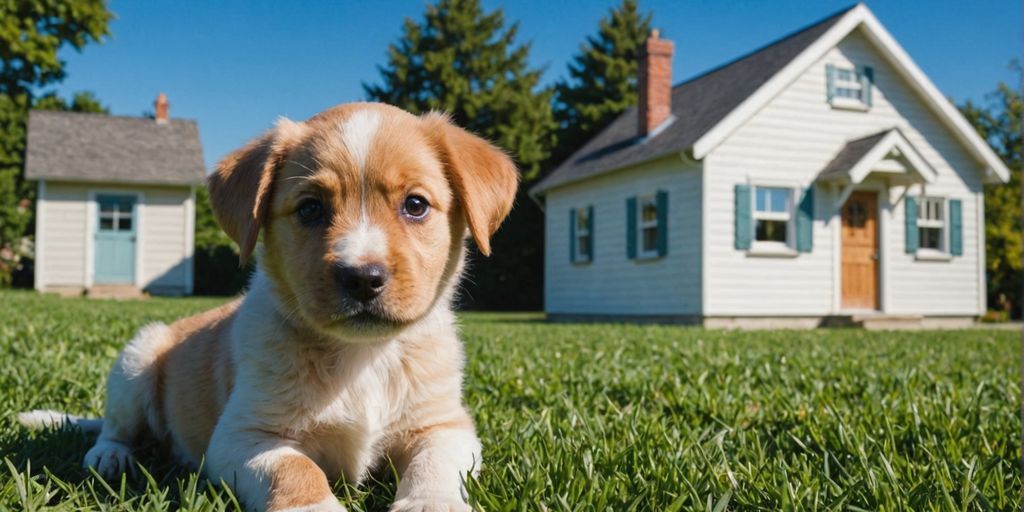Housebreaking a new puppy is a big task, but it's also an important one. With patience and the right approach, you can help your puppy learn good habits that will last a lifetime. This guide will walk you through essential tips for housebreaking, making the process smoother for both you and your furry friend.
Key Takeaways
- Establish a routine for feeding, bathroom breaks, and playtime to help your puppy learn what to expect and when.
- Crate training can provide a safe space for your puppy and help with housebreaking by teaching them to hold their bladder.
- Puppy-proof your home by removing hazards and providing chew toys to keep your puppy safe and entertained.
- Use positive reinforcement like treats and praise to encourage good behavior and make training a positive experience.
- Avoid physical punishment as it can create fear and mistrust; instead, focus on redirection and building a strong bond with your puppy.
Establishing a Consistent Routine
Creating a consistent routine for your puppy is crucial for effective housebreaking. Establishing a reliable routine helps your pup understand when it's time to eat, play, and go potty, making the training process smoother for both of you.
Crate Training Benefits
Crate training offers numerous advantages for both puppies and their owners. A crate provides a secure way to transport your dog and travel safely. It also helps with housebreaking, prevents destructive behavior, and can ease separation anxiety.
Choosing the Right Crate
Selecting the appropriate crate is crucial. The crate should be just large enough for your puppy to stand, turn around, and lie down comfortably. If it's too big, your puppy might use one corner as a bathroom. Many crates come with adjustable partitions to accommodate your puppy's growth.
Positive Reinforcement Techniques
Using positive reinforcement is key to successful crate training. Encourage your puppy to enter the crate willingly by offering treats, praise, and toys. The crate should be associated with positive experiences and never used for punishment.
Avoiding Common Mistakes
Avoid common pitfalls like using the crate as a form of punishment or leaving your puppy in the crate for too long. Gradually increase the time your puppy spends in the crate and always ensure they have had a bathroom break before being crated. If your puppy soils the crate, it may be a sign that the crate is too large or that they need more frequent bathroom breaks.
Puppy-Proofing Your Home
Removing Hazards
Puppies are naturally curious and love to explore their surroundings. To keep your new companion safe, it's important to remove any hazards from your home. This includes securing hazardous areas, keeping electrical cords out of reach, and removing toxic plants and foods. Make sure to protect valuables and breakables as well.
Providing Chew Toys
Puppies have a natural instinct to chew. To prevent them from chewing on your furniture or other valuable items, provide plenty of appropriate chew toys. This will not only keep them entertained but also help in satisfying their chewing needs.
Securing Valuable Items
It's essential to secure valuable items to prevent any accidents or damage. Keep items like shoes, remote controls, and other small objects out of your puppy's reach. Creating a safe space for your puppy where they can play without getting into trouble is also a good idea.
Puppy-proofing your home is a crucial step in ensuring your puppy's safety and well-being. By removing hazards, providing chew toys, and securing valuable items, you can create a safe and happy environment for your new furry friend.
Setting Rules and Boundaries
Consistency Among Family Members
It's important that everyone in the household is on the same page when it comes to training your puppy. Consistency is key to helping your puppy understand what is expected of them. If one person allows the puppy on the couch while another does not, it will confuse the puppy and make training more difficult.
Creating Clear Guidelines
Set clear and simple rules for your puppy. Decide where they are allowed to go, what they can chew on, and where they should sleep. Make sure these rules are easy for everyone to follow. This will help your puppy learn faster and reduce the chances of them developing bad habits.
Reducing Confusion and Undesirable Behaviors
By having consistent rules and boundaries, you can reduce confusion for your puppy. This will help prevent undesirable behaviors like chewing on furniture or having accidents inside the house. Remember, a well-trained puppy is a happy puppy, and a happy puppy makes for a happy owner.
Establishing clear rules and boundaries is crucial for your puppy’s development. Create consistent guidelines that all family members follow. This helps your puppy understand what is expected and reduces confusion, which can lead to undesirable behaviors.
Positive Reinforcement Strategies
Using Treats and Praise
Positive reinforcement is a powerful tool in puppy training. When your puppy does something right, reward them with treats or praise. This encourages them to repeat the good behavior. For example, if your puppy potties in the correct spot, give them a treat immediately. This helps them understand that they did something good.
Timing of Rewards
The timing of rewards is crucial. Make sure to give the treat or praise right after the desired behavior. If you wait too long, your puppy might not connect the reward with the action. Quick rewards help your puppy learn faster and more effectively.
Building a Positive Training Experience
Creating a positive training experience is essential. Use rewards like treats, toys, or affection to make training fun. This keeps your puppy motivated and eager to learn. A happy puppy is more likely to follow commands and behave well.
Remember, positive reinforcement creates a bond of trust between you and your puppy. It makes training enjoyable and helps your puppy feel secure and loved.
Avoiding Punishment
The Impact of Physical Punishment
Using physical punishment or harsh scolding can create fear and mistrust in your puppy. This can hinder the training process and damage the bond between you and your pet. Instead of punishment, focus on positive reinforcement to guide your puppy's behavior.
Redirection Techniques
When your puppy makes a mistake, use redirection techniques. For example, if they start chewing on furniture, gently redirect them to a chew toy. This method teaches them what is acceptable without causing fear.
Building Trust and Bonding
Avoiding punishment helps build trust and a strong bond with your puppy. When your puppy feels safe and loved, they are more likely to respond positively to training. Remember, redirection without fear is the fastest way to teach your puppy the right behaviors.
Building a trusting relationship with your puppy is essential for effective training and a happy pet.
Troubleshooting Common Housebreaking Issues
Housebreaking a puppy can be challenging, and sometimes things don't go as planned. Here are some common issues and how to address them.
Dealing with Accidents
If your dog has an accident, don't make a fuss. Just clean up the mess using a cleaner that eliminates odors. This prevents your dog from using the same spot again. If you catch your dog starting to squat, pick them up and rush outside. Praise them if they finish their business outdoors.
Addressing Repeated Soiling Spots
Dogs often return to spots where they previously had accidents. This is likely because the odor wasn't completely removed. Use pet stain enzymatic cleaners to eliminate all traces of the scent. Follow the instructions carefully to ensure effectiveness.
When to Seek Professional Help
Sometimes, house soiling can be a sign of a physical issue. If your dog seems impossible to house train, a veterinary checkup is essential. If your vet finds no health issues, consider consulting a trainer or behaviorist experienced in housebreaking problems.
Remember, prevention is key when it comes to housebreaking. Stay consistent and patient, and your puppy will learn in time.
Conclusion
Housebreaking a puppy is no small task, but with patience, consistency, and a lot of love, it can be done successfully. Remember to establish a routine, use positive reinforcement, and avoid punishment. Crate training can be a helpful tool, and always make sure your home is safe for your curious new friend. Every puppy is different, so be prepared for some trial and error. Stick with it, and soon your puppy will learn where to do their business, making life easier and more enjoyable for both of you.
Frequently Asked Questions
How long does it take to housebreak a puppy?
Housebreaking a puppy can take anywhere from a few weeks to several months. It depends on the puppy's age, breed, and how consistent you are with the training routine.
What should I do if my puppy has an accident inside?
If your puppy has an accident inside, clean it up immediately with an enzymatic cleaner to remove the scent. This helps prevent the puppy from using the same spot again.
How often should I take my puppy outside for bathroom breaks?
Take your puppy outside every 1-2 hours, especially after eating, drinking, playing, or napping. Puppies have small bladders and need frequent bathroom breaks.
Is crate training necessary for housebreaking?
Crate training can be very helpful for housebreaking. It provides a safe space for your puppy and encourages them to hold their bladder, as they usually don't like to soil their sleeping area.
What is the best way to reward my puppy for going potty outside?
The best way to reward your puppy is with treats and praise immediately after they go potty outside. This helps them understand that they did the right thing.
Should I punish my puppy for accidents?
No, you should not punish your puppy for accidents. Punishment can create fear and confusion. Instead, focus on positive reinforcement and redirecting them to the appropriate potty spot.

